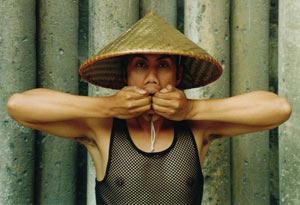 |
| CanAsian Dance Festival
Feb. 23 – 27, 2005 • Premiere Dance Theatre • Toronto
|
|
|
| Report by David Fujino |
play (2002)
Choreographer: Hari Krishna
Opening Night. The theatre is black. A blown shenai wails, and a heart-pounding hand drum turns our heads. A woman bearing a pot-lamp lights the way for a slow single file procession of nine performers, men and women, walking down through the audience and onto the stage to begin this regal set of five temple and court dances from South India.
This is classic, stirring. The ensemble swirls across the stage. The barefoot dancers stomp, one palm down, the other palm up, like living sculptures on Hindi temples. Dancers surge toward each other, and their heads lilt from side to side, as the onstage orchestra with singer, narrator, violin, tabla drums and hand bells, drives them on.
play (2002) groups and regroups dancers into nine, five, one, and two partner combinations. After this point, I stopped counting, and I listened to the changing rhythms of the tabla drums, and was moved by the dancers on stage. There’s such a vibrant and interactive unity to this piece.
The fifth biennial CanAsian Dance Festival — is on!
|
|
|
Field (Excerpt)
Choreographer and Performer: Alvin Erasga Tolentino |
| The second dance. A large hump-shaped silhouette is cast upon a huge video screen, which is pullulating with a swarm of brown locusts. The black shape then unfolds into a human silhouette standing upright, wearing a triangular rice planter’s hat. Man confronted by nature. As the electronic score screels and rumbles, the man approaches then retreats from the screen of pouring locusts. He gradually moves away from the screen, at times stopping to reveal an open agonized mouth, as he paces and shifts in the hard rectangles of white light hitting the black floor at stage left, stage right, and in front of the huge video screen. Man struggles and prepares to plant rice. |
|

Alvin Erasga Tolentino |
|
|
Field is a clear and intriguing dance metaphor. The audience witnesses the invasion of locusts; and we survey the wet rice fields where the difficult and uncertain rice planting will occur, until at the dance’s end, we are gladdened to see this man kneeling with a woven tray, triumphantly tossing and tossing his harvest of rice in the air.
|
|
|
|
A Sorrowful Departure (Excerpt)
Dancer: Lu Min as Xue Ping Gui
Music by the Shanghai Peking Opera Company
In this solo piece, we are treated to the finely detailed movements of Peking Opera.
Lu Min enters briskly with bright eyes. A mostly white costume hangs like a great coat, the face of a wild boar embroidered on the front panel. Four attached flags fan out over his back. Is he a warrior?
He strides forward, both hands spinning in a blur; stops, speaks in Mandarin, and his left leg pops up to the ceiling. He got a laugh. His intense facial gestures and sudden decisive body movements are so controlled, with the surmounting eyes and face, sometimes ironic, always alert.
According to the programme notes, Lu Min’s character is being sent to the frontlines of the war by his vengeful father-in-law, and he is saying goodbye to his beloved wife. (It was some goodbye.)
|
|
|
|
Source
Performed by: George Gao and Andrea Nann
Composer: George Gao
Source is a newly commissioned work, a duet between a dancer and a musician.
Lit against black — a woman is in a state of abandonment, her arms and head thrown back, skyward. She stands on large wooden clogs. Her hands graze her breasts, then from her breastbone area she slowly starts pulling out a red ribbon of agony, which pools at her feet. She carries this red pool forward, places it on the floor, and steps out of the wooden clogs. Then she exits.
George Gao is revealed. He is seated on stage right, playing the erhu, the Chinese stringed instrument. The dry, grainy sound of the erhu is emphasized.
Andrea Nann enters. She picks up a Y-shaped branch. It’s like a divining rod which moves and exerts its own energy. She is on a quest.
Nann’s sequences, and her imagery, happen at the right time, at the right place. The perfect accent to a diverse and creative evening of dance.
|
|
|
|
|
|
|


